Here’s a great beef mince recipe for you that’s quick to make, economical and full of hidden vegetables so it’s a complete meal – Beef Chow Mein! It’s the beef version of everybody’s favourite Chicken Chow Mein, made with the convenience of ground beef.
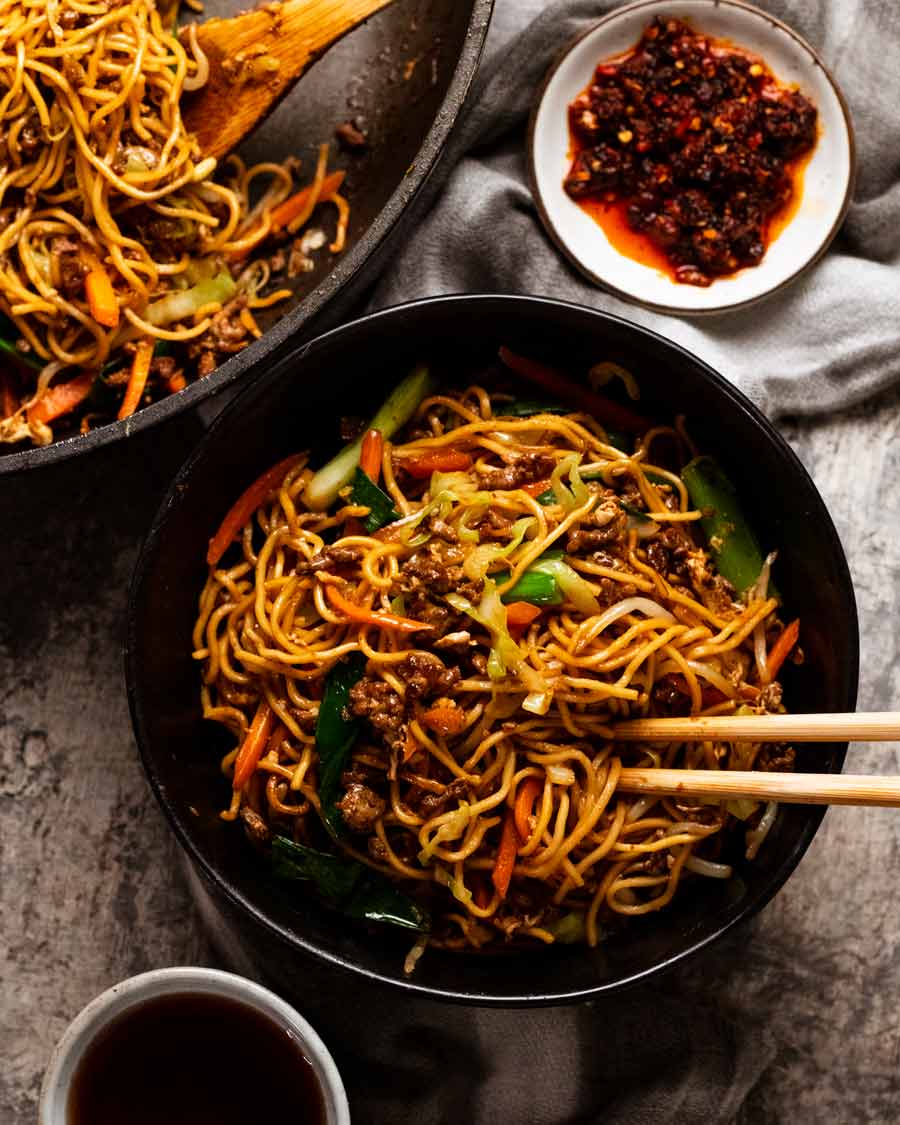
Beef chow mein
Here’s something new to try with that packet of beef mince you throw into your shopping cart every week! The beef is stir fried with chow mein sauce until it’s beautifully caramelised then tossed in a tangle of noodles and vegetables.
A neat trick in today’s recipe is to scramble up an egg with the beef. It makes the beef bits stick to the noodles better, with the added bonus of upping the protein.
Another bonus: chow mein actually has a vast amount of noodle-shaped vegetables hidden in the noodles. A carrot, 2 heaped cups of cabbage and a heaped cup of bean sprouts. That’s a good veg serving for a meal!
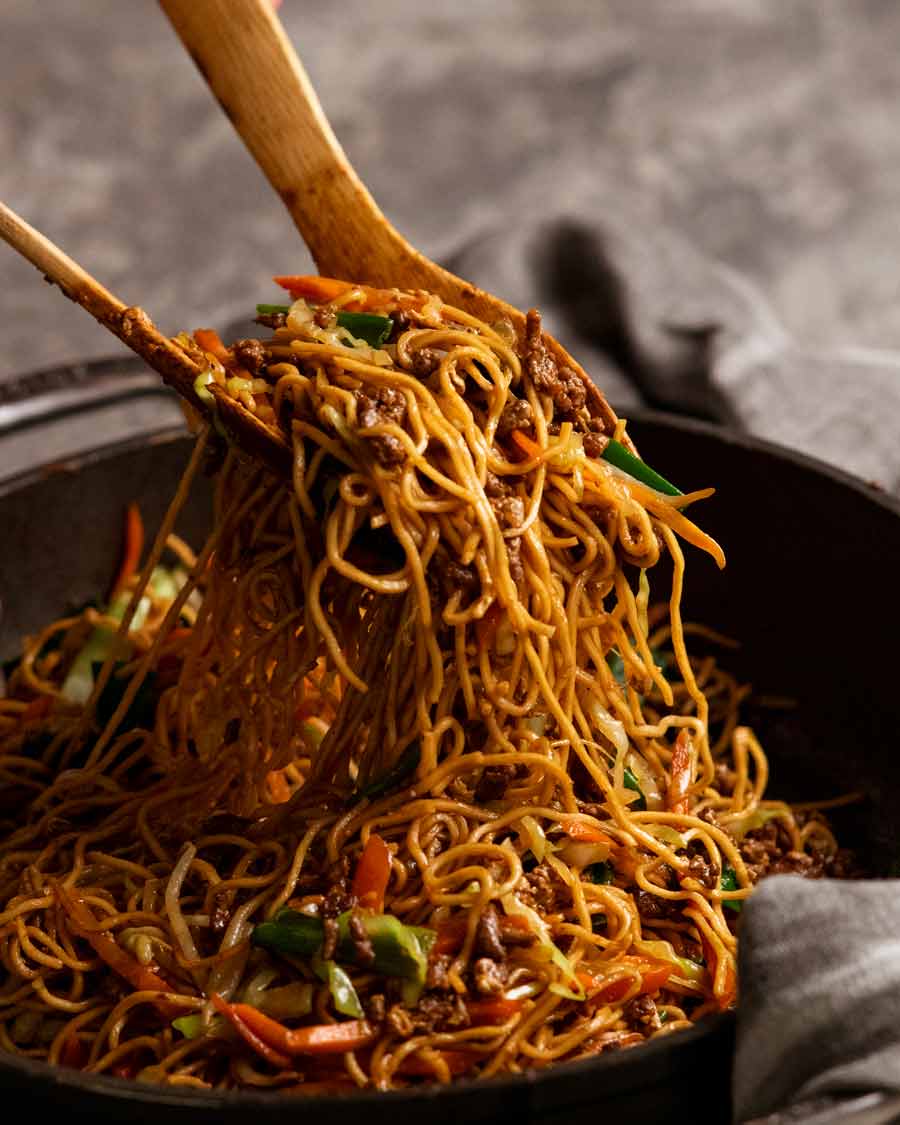
What you need
Here’s what you need to make this:
Noodles & add-ins
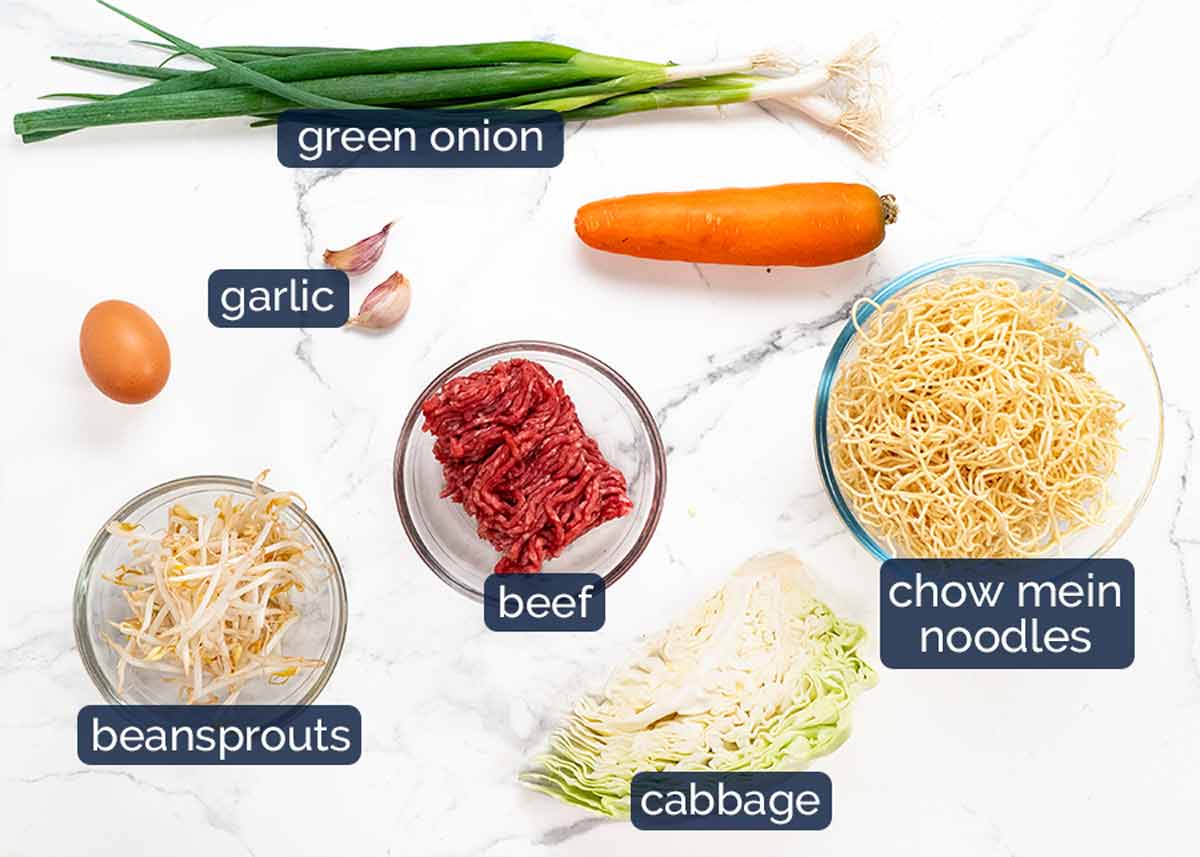
-
Noodles – Chow mein noodles are sort of dry and crinkly, rather than oily and straight like hokkien noodles, lo mein noodles. But this dish can really be made with any noodles – or even spaghetti (yes really, who’s going to know once tossed in chow mein sauce??). Use the same weight.
-
Garlic – Rarely do Asian stir fries happen without garlic, and this one is no exception!
-
Beef mince – That’s ground beef to Americans. Any fat % is fine here though lean beef won’t caramelise quite as well.
Other proteins – Any other mince will work just fine here. Chicken, pork, turkey, even lamb! Though bear in mind the sauce is quite intense flavoured to suit the beefy flavour of beef, so you won’t taste the flavour of white meats through the sauce.
-
Egg – We use this to scramble into the beef. Neat trick to make the beef stick to the noodles better with the added bonus of a free protein boost!
-
Green cabbage – Or Chinese cabbage. Finely sliced so it disappears into the tangle of noodles.
-
Bean sprouts – Excellent grab-and-throw-in vegetable option! STORAGE TIP: Keep bean sprouts in water in an airtight container. Change the water every couple of days. This will increase the shelf life of beansprouts 3x.
-
Carrot – Cut into thin batons. More noodle shaped vegetables so it all jumbles up together!
-
Green onion – We use 3 whole stems here. They are the onion in this dish, as well as some fresh green colour.
Chow Mein Sauce
The combination of sauces used in Chow Mein is common in Chinese dishes.
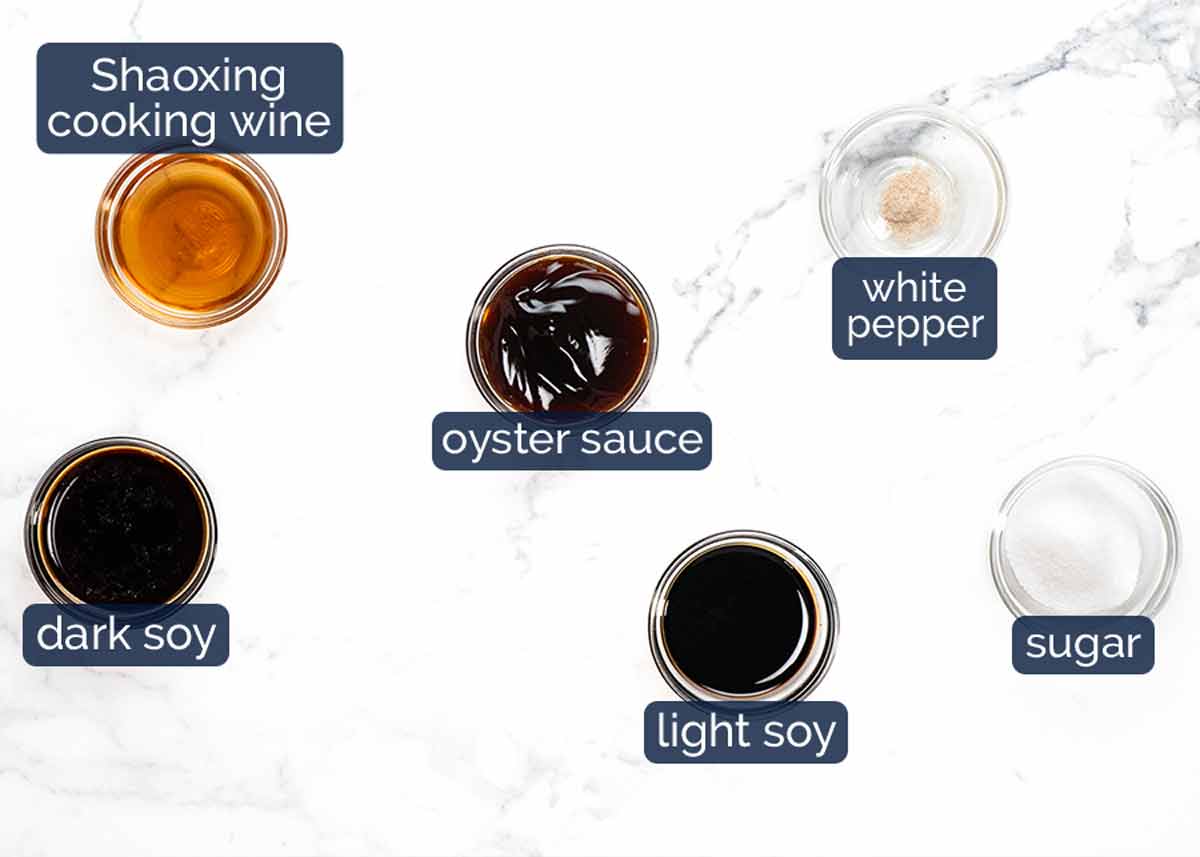
-
Soy sauces – We’re using both light and dark soy sauce in this recipe. What’s the difference? Dark soy stains the noodles a lovely warm mahogany colour as well as adding soy flavour. Light soy sauce provides the salt without overwhelming with soy flavour, and does not stain the rice.
Substitutions -You can use only light soy sauce or just an all-purpose soy sauce (ie bottle just labelled “soy sauce” without “light” or “dark” in front of it) instead of dark soy sauce. But you cannot use only dark soy sauce as the flavour is too strong! More on different types of soy sauces here.
-
Oyster sauce – A load of flavour, all in one sauce! It’s sweet and savoury and adds a neat flavour shortcut in dishes. Makes a regular appearance in Asian dishes, from Pad See Ew to Asian Glazed Salmon to Honey Pepper Beef to Supreme Soy Noodles. And Steamed Asian Greens with Oyster Sauce!
Vegetarian oyster sauce is available these days, at Asian stores and some large grocery stores (Australia – there’s Ayam vegetarian oyster sauce at Woolies). Otherwise, hoisin is a good alternative. Slightly different flavour profile (hint of Chinese five spice) but similar savoury / sweetness.
-
Chinese cooking wine (Shaoxing wine) is an essential ingredient for making truly “restaurant tasting” Chinese dishes. Without it, the dish will be lacking something. Substitute with Mirin, cooking sake or dry sherry.
Non alcoholic sub – sub both the cooking wine and water with low sodium chicken broth/stock.
-
Cornflour / cornstarch (left out of photo – oops!) – For thickening the sauce so it clings to the noodles. It also makes the sauce lovely and glossy.
-
White pepper and sugar – For seasoning.
How to make Beef Chow Mein
Be sure to cook the beef well once you add the sauce to get it really nicely caramelised, for a free flavour boost!
1. Sauce & thickener

-
Sauce – Mix the soy sauces, oyster sauce, Chinese cooking wine, sugar and pepper in a small bowl. We’re going to use some to flavour the beef, then we will mix the rest with the sauce thickener (next step) to make the noodle sauce.
-
Sauce thickener (cornflour slurry) – Mix the cornflour / cornstarch and water in a separate small bowl. This is what thickens the sauce so it coats the noodles, as well as making it shiny and glossy.
2. Making the stir fried noodles

-
Prepare the noodles per the packet directions then drain. I usually get the water boiling while I’m prepping the vegetables then cook the noodles when I start cooking. The chow mein noodles I get just call for soaking in hot water for 3 minutes. Some brands need to be boiled.
-
Caramelise beef – Using a large non-stick pan, cook the garlic first to flavour the oil. Then cook the beef, breaking it up as you go, until you can no longer see raw beef.
Then add the white part of the green onions and 1 1/2 tablespoons of the Sauce. We add the white part of the green onions first as it takes longer than the green part. Cook for another 2 minutes to get the beef nicely caramelised.
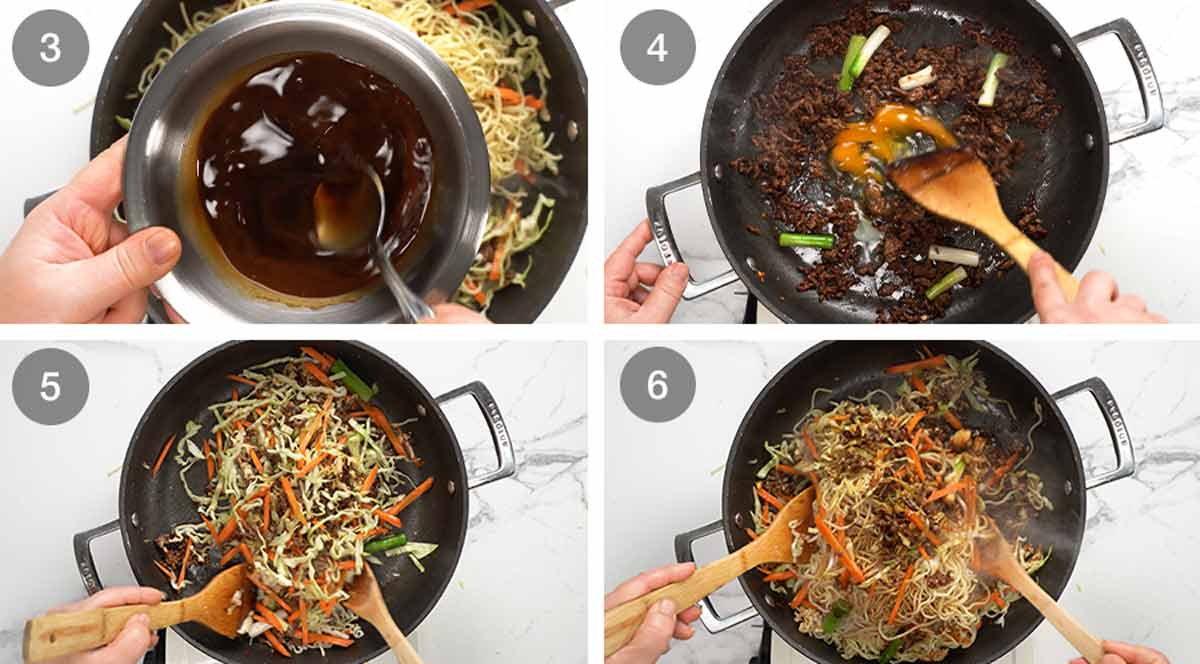
-
Finish sauce – Meanwhile, mix the cornflour slurry into the remaining sauce.
-
Scramble egg – Add the egg into the pan then mix it through the beef, it will sort of scramble into the mixture. This is what makes beef stick to the noodles better!
-
Keep cooking! – When the egg is mostly cooked, add the carrot and cabbage. Cook for 1 minute until cabbage starts to wilt.
-
Sauce & noodles – Give the sauce a quick mix. Add the bean sprouts, noodles and sauce into the pan. Toss well for 1 minute or until sauce is dispersed through the noodles. Add green part of green onions. Toss for another 1 minute, then serve!
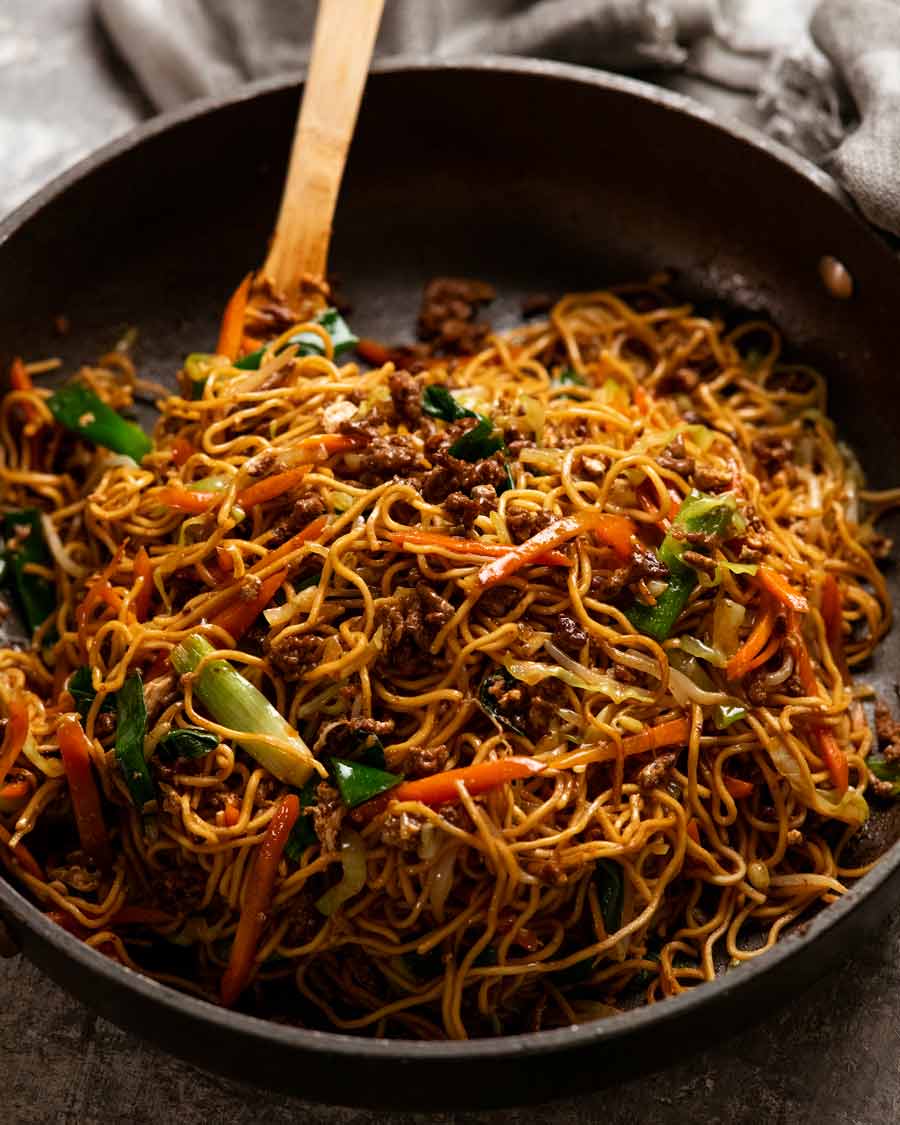
So there you go! Stir fried noodles for dinner, relatively low effort and quick to make. Great way to get a noodle fix, very economical, and highly versatile – switch out the vegetables and proteins with what you’ve got or what you love.
Enjoy! – Nagi x
Watch how to make it
Hungry for more? Subscribe to my newsletter and follow along on Facebook, Pinterest and Instagram for all of the latest updates.
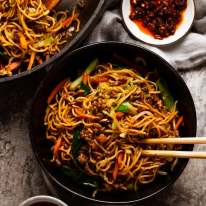
Beef Chow Mein – great beef mince noodle recipe!
Prep: 15 mins
Cook: 10 mins
Mains
Asian, Chinese
Servings2
Tap or hover to scale
Instructions
-
Sauce – Mix ingredients in a small bowl then set aside. Some is used to flavour the beef, then the rest for the noodles.
-
Sauce thickener (cornflour slurry) – Mix the cornflour / cornstarch and water in a separate small bowl.
-
Prepare noodles per packet directions then drain.
-
Cook beef – Heat the oil in a large non-stick pan over high heat. Cook garlic for 10 seconds, then add the beef and cook until you can no longer see pink. Add 1 1/2 tablespoons of the Sauce and the white part of the green onions. Cook for another 2 minutes to get the beef nicely caramelised.
-
Finish sauce – Mix the cornflour slurry into the remaining sauce.
-
Egg – Add the egg into the pan then mix it through the beef, it will sort of scramble. Egg makes the beef stick to the noodles better!
-
Cabbage & carrot – When the egg is mostly cooked, add the carrot and cabbage. Cook for 1 minute until cabbage starts to wilt.
-
Sauce & noodles – Give the sauce a quick mix. Add the bean sprouts, noodles and sauce into the pan. Toss well for 1 minute or until sauce is dispersed through the noodles. Add green part of green onions. Toss for another 1 minute.
-
Serve – Divide between bowls and serve!
Recipe Notes:
2. Soy sauce – Light soy sauce and all-purpose soy sauce add salt but doesn’t add much soy flavour or colour. The dark soy sauce stains the noodles a brown colour and adds soy flavour. It’s intense so you don’t need much!
3. Oyster sauce – Sweet and savoury, adds depth of flavour to an otherwise simple sauce. Sub with vegetarian oyster sauce (available in some large grocery stores and Asian stores these days) or Hoisin (different flavour with hint of five spice but similar savouriness and sauce thickness).
4. Chinese cooking wine (“Shaoxing wine”) is an essential ingredient for making truly “restaurant standard” Asian noodles. Substitute with Mirin, cooking sake or dry sherry.
Non alcoholic sub – sub both the cooking wine AND water with low sodium chicken broth/stock.
5. Keep beansprouts submerged in water in an airtight container in the fridge. Change the water every couple of days. This will extend the shelf life 3x. Also, here in Australia, bean sprouts at Asian stores are much better quality than ordinary grocery stores!
6. Leftovers will keep for 3 to 4 days in the fridge. Will freeze fine but not ideal – noodles get a little soft.
Nutrition per serving. Serves 2 very generously – more like 2 1/2 servings.
Nutrition Information:
Calories: 664cal (33%)Carbohydrates: 71g (24%)Protein: 32g (64%)Fat: 30g (46%)Saturated Fat: 8g (50%)Polyunsaturated Fat: 4gMonounsaturated Fat: 14gTrans Fat: 1gCholesterol: 149mg (50%)Sodium: 1681mg (73%)Potassium: 732mg (21%)Fiber: 6g (25%)Sugar: 11g (12%)Vitamin A: 5473IU (109%)Vitamin C: 39mg (47%)Calcium: 100mg (10%)Iron: 6mg (33%)
My noodle life
Life of Dozer
Visited our old stomping ground on the weekend – Bayview dog beach! Plenty of Dozer smiles that morning.

